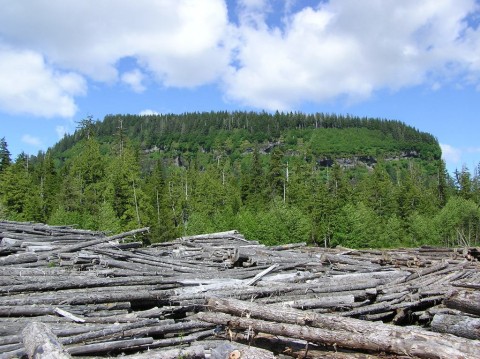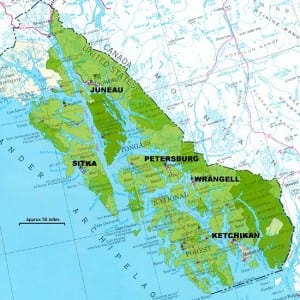
Beached logs pile up in Shoal Cove on Revilla Island in the Tongass National Forest. A new report challenges old-growth logging spending in the forest. (Jim Baichtal/USFS)
A new report says the U.S. Forest Service is wasting millions of dollars by propping up a failing Southeast Alaska timber industry. It says the Tongass National Forest should instead invest in projects supporting tourism and fishing, which are growing segments of the economy.
Headwaters Economics, a Montana-based research firm, prepared the study with funding from two conservation-oriented foundations.
It was released by the Alaska chapter of Trout Unlimited, which is critical of Tongass logging.
“The Tongass has historically been a national forest focused on old-growth harvesting and it looks very much today like the same thing,” says Ben Alexander, Headwaters’ associate director.
“The underlying economics in Southeast Alaska have shifted radically and the growth sectors and the sectors creating jobs and opportunities for communities and businesses now are no longer in timber,” he says.
The report says the Forest Service spent more than $100 million subsidizing old-growth logging over the past five years.
Alaska Regional Forester Beth Pendleton didn’t have the information at hand to confirm or deny that figure.
But she says the Headwaters report does not accurately describe how agency funding works. She says Congress, not her office, decides how much goes to programs such as timber, fishing and tourism.
“I believe that the report, while well-intentioned, is flawed. And I think it shows some naivety relative to how the federal budgets are allocated,” she says.
Ross Gorte, a research professor involved in the report, says that’s sidestepping the problem, which he says is in Washington, D.C.
“They don’t tell the Forest Service how much money to spend on recreation in the Tongass versus how much to spend on recreation in Washington or Alabama or anywhere else,” he says.
“We do have some flexibility relative to policy and how we implement certain program direction,” says Pendleton.
She says that’s allowing her agency to start moving away from old-growth logging. The goal is to do that in 10 to 15 years.
“So over the last five years, we’ve been putting an increasing emphasis on that transition to young growth,” she says.
The Headwaters report says the agency has moved too slowly.
Austin Williams is Alaska policy director for Trout Unlimited.
“It’s frankly not clear when that time frame might start or end. And there’s an opportunity to speed it up. Ten to 15 years is just too long and it’s not getting at the real needs of Southeast Alaska communities,” he says.
The Forest Service says a change this big doesn’t happen overnight.
Pendleton says the planning process is ongoing, including consulting with an appointed Tongass Advisory Committee representing different interest groups. That panel meets this week in Sitka.
“The planning process takes time. It’s one that’s based on collaborative engagement with our communities and [the] public and also through the offering of stewardship contracts. So these things do take some time, but we’re making some progress in that direction,” she says.
A separate report, from an industry consultant and an environmental scientist, says the transition could happen in five years.
The Forest Service says that’s not realistic. But Pendleton says the research is part of the advisory committee’s discussion.









